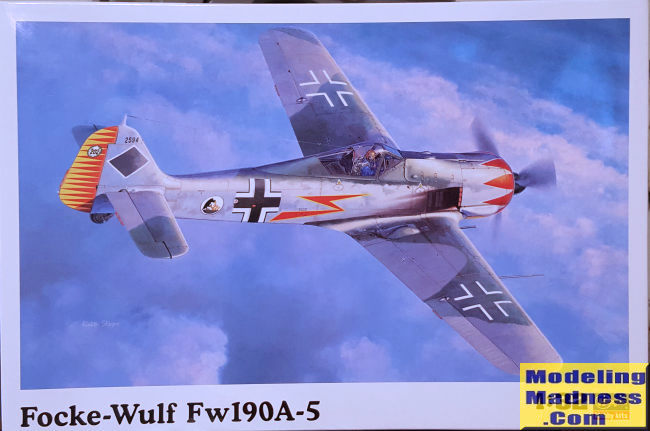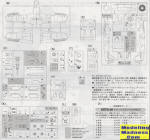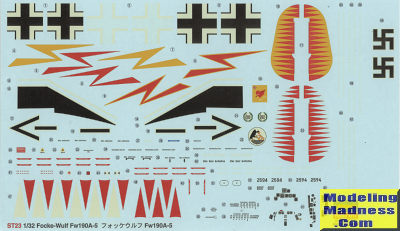
Hasegawa 1/32 FW-190A-5
| KIT #: | 08073 |
| PRICE: | 4200 yen SRP in 2004$20.00 'Used' |
| DECALS: | Two options |
| REVIEWER: | Scott Van Aken |
| NOTES: | 2004 base boxing |

| HISTORY |
The FW-190 was considered by many German pilots to be the best fighter of the war. It was more maneuverable than most fighters at medium to low altitude, had a respectable armament and its wide track landing gear greatly reduced ground handling accidents.
The type had a bit of a rocky start with issues regarding engine fires until the exhaust was re-routed on the underside, taking care of the overheating issues. The A-5 was developed after it was determined that the Fw 190 could easily carry more ordnance. The D-2 engine was moved forward another 15 cm (6 in) as had been tried out earlier on the service test A-3/U1 aircraft, moving the centre of gravity forward to allow more weight to be carried aft.
For many, the longer nose is the dividing point between the early and later versions of the FW-190A.
| THE KIT |
 Developed
in 2004, this kit was part of a program by Hasegawa to model significant WWII
fighters in 1/32 scale. Often touted as the best there is in this scale, it
shares a number of its parts with the FW-190D kit. This is only one of two
FW-190A variants kitted by Hasegawa, the other being the more widely produced
FW-190A-8. There are differences between the two variants, the biggest being the
upper cowling and the main gear doors. These are taken care of by additional
sprues.
Developed
in 2004, this kit was part of a program by Hasegawa to model significant WWII
fighters in 1/32 scale. Often touted as the best there is in this scale, it
shares a number of its parts with the FW-190D kit. This is only one of two
FW-190A variants kitted by Hasegawa, the other being the more widely produced
FW-190A-8. There are differences between the two variants, the biggest being the
upper cowling and the main gear doors. These are taken care of by additional
sprues.
As these big kits go, this one is fairly simple, comprising of only 108 parts. The cockpit is fairly well done and Hasegawa does provide a pilot. Those not wanting the crew will want to find an aftermarket seat harness. You have the option of paint or decals for the various instrument panels in the plane. Those who can't handle stock interiors will find lots of help from aftermarket.
The engine cowling is five main pieces into which you install the engine (four pieces), and the exhaust. The prop has separate blades and is keyed for proper alignment. It also has the polycap for installation so it along with the engine fan can be left off until the end. At this time, the interior and tail gear assembly is trapped between the fuselage halves. Note that some modification of the fuselage is needed as it is for the later A-8 version.
When assembling the wings holes need to be opened for the pitot and the step. The main gear well is heavily braced to ensure the proper wing diheadral and you are told to install the lower wing and flaps on the fuselage before attaching the upper wings. Flaps are molded in the lowered position. Next are the cowling pieces and guns.
For the underside you have the main gear with two piece wheels and separate oleo scissors. This version carried inner gear doors, hence the different main gear doors. There are also inserts for the underside of the wing and various antennas. The only canopy provided is the early version as the later one did not happen until 1945 so no A-5 wore this.
 There
are two markings options provided. Both are in the standard RLM 74/75/76Both of
these have yellow rudders and yellow lower cowling sections. One is the tulip
nose version on the box art flown by Herman Graf in 1943. You have two options
for the rudder markings; one where you paint the rudder. Note that on this
plane, the nose markings start after the armored nose ring so you may wish to
apply that item after the kit is painted and decaled. The other is Walter
Oesau's plane, also from 1943. This aircraft has no fuselage mottling. Decals
are nicely printed, but are old school Hasegawa which means off-white whites and
the need for hot water. Might want to check for aftermarket.
There
are two markings options provided. Both are in the standard RLM 74/75/76Both of
these have yellow rudders and yellow lower cowling sections. One is the tulip
nose version on the box art flown by Herman Graf in 1943. You have two options
for the rudder markings; one where you paint the rudder. Note that on this
plane, the nose markings start after the armored nose ring so you may wish to
apply that item after the kit is painted and decaled. The other is Walter
Oesau's plane, also from 1943. This aircraft has no fuselage mottling. Decals
are nicely printed, but are old school Hasegawa which means off-white whites and
the need for hot water. Might want to check for aftermarket.
| CONCLUSIONS |
The nice thing about these Hasegawa 1/32 scale kits is that they are not fiddly as seems to be the norm for kits today. This means a fairly trouble-free build. Only issue might be finding one and when you do it could be pricey.
August 2020
Copyright ModelingMadness.com. All rights reserved.
Review kit courtesy of my wallet If you would like your product reviewed fairly and fairly quickly, please contact the editor
or see other details in the
Note to
Contributors. Back to the Main Page
Back to the Review
Index Page
Back to the Previews Index Page